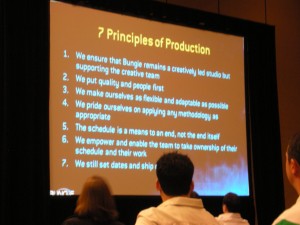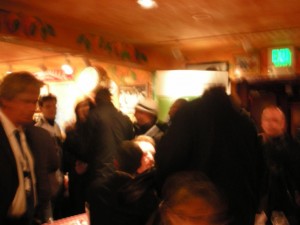My first day of the GDC 2009 is over and I decided to write up a short rundown of my day and review the different lectures. If you’ve got any questions I’ll be more than happy to share more information.
2D Boy: Everything You Always Wanted to Know About Going Indie But Were Afraid to Ask
The first lecture of the day was held by Ron Carmel, one half of 2D Boy, the creators of the charming World of Goo. Ron was providing some interesting insight into the development process. What I found especially valuable was the look at the distribution: Things like percentages for the different platforms (WiiWare, Steam, 2D Boy Website…) and the develpoment of sales over time. Also the slides to the presentation are available here.
2008 IGF Finalist Overview
This lecture was basically just a quick rundown of all IGF Finalists presented by Steve Swink. It was nice to see the wide variety of the games. I’m just glad I’m not one of he judges because the games were so different that I’d find it really hard to compare them. Also I have to say that I do have a fondness for The Unfinished Swan.
Independent Games & Sales: Stats 101
This 30 minute lecture had the goal to present a closer look at the numbers behind indie games. This sounded really interesting to me since having some hard numbers would be helpful to judge going indie. Unfortunately Simon Carless‘ lecture consisted of too many slides with too much text presented in too little time.
And worst of all, the many many numbers were presented without context to one another. A few graphs would have been wonderful here. Regardless the lecture provided a few interesting numbers and I did like the fact that Simon was clearly marking which numbers were officially released and which ones were guesswork.
Indie Games: From Buzz To Business
Moderated by Game Attorney Tom Buscaglia, this lecture focused on using the Buzz generated from an adward or big press mention to create or boost a business. Present to share their experience were Dylan Fitterer, creator of Audiosurf, Michael Wilford from the Maw team and Zach Aikman, founder of Fishbeat.
The session was basically a moderated panel and there were a few gems but in general I did not find it too helpful. After fifteen minutes the most important things had already been said and the session seemed to lull. One nice funny point though: Dylan Fitterer simply put ads in the paper to get random people to test his game for a few bucks.
The Four-Hour Game Design by Cactus
Jonatan Söderström (aka Cactus) documented his reasons and methods for creating games in four hours. The presentation was very entertaining and diverse. I especially enjoyed the different methods for “quick and dirty” graphics. Even though the lecture was very funny I felt that it was only scratching the surface. Talking about sound, music and graphics is leaving out the topic of code, which (at least to me) is a higher hurdle: Everyone can do cheap graphics in paint or steal sounds and music from the interweb but coding a game is a lot more difficult. A small gem though: He mentioned SFXR, a tool to create sounds that looked really interesting.
CRAYON PHYSICS DELUXE Postmortem
Petri Purho of Kloonigames, the creator of the famous Crayon Physics shed some humorously tinted light on the project. It initally begun as a simple prototype in a 1 game a week project, he uploaded a YouTube video and the many many views it got showed that there was more to the concept than a throwaway prototype.
So the idea for Crayon Physics Deluxe was born and independent production began. And took much longer than expected. Demotivated by a wealth of clones Petri still completed the project and the game is now available for PC and iPhone, though the iPhone version was developed by Hudson.
Interesting to me was the initial idea of Petri that the game should encourage playful solutions to the given problems. And while there are players who come up with extremely complex, rube goldberg machines, most players simply blazed through the level in the simplest way possible.
A video of the lecture is available at YouTube.
Embracing Constraints
Dylan Fitterer, creator of Audiosurf was holding this talk on the importance of constraints for design as opposed to designing from an clean slate.
This is something I absolutely agree with and have been saying for a while now. I think that this is applicable to all createive endeavos and I’ve even adapted/developed a few techniques to create random constraints for myself to fuel my imagination. A good example is when I am the storyteller for a Pen and Paper Roleplaying game. I often tend to ask my players for random input – words, locations, settings, characters, scenes. I then use this input to come up with an interesting scenario much faster than if I was working from scratch.
What happens there is that this (not quite) random input forces my brain to think in ways it would otherwise not. It creates connections between the data from the different players that would have otherwise not happened.
Design Today
This lecture was a series of presentations from a wide variety of Casual Game Designers. (Jason Kapalka, Miguel Tartaj, Michael Wyman, Jane Jensen, Nick Fortugno, Kenny Shea Dinkin and Todd Kerpelman). Each one was talking about a certain “genre” of Casual Game, going into detail about the Design dos and don’ts.
While it was interesting to get an overview over the “genres” of Casual games, the lecture itself was quite boring after a short while since much information seemed to repeat itself. It went so far that I decided to bail early. However what I took from that is that there’s a series of genres – or rather templates of Casual Games. That is that a popular game has established itself and a lot of clones are created. Templates are things such as the hidden object game, the tower defense, the time management game…
No Publisher? No Problem! iPhone for Indies
After a long day, this presentation was the last. Held by Sergei Gourski (Fieldrunners) and Adam Saltsman (Wurdle) the two were discussing their path and experiences with Indie development for the iPhone. Unforunately I have missed a large part of it since I joined after leaving the Design Today lecture. What I found interesting though was that quality seems to be no deciding factor when it comes to the success of a iPhone game, it seems to be more about a short and simple concept. The “mood ring” game – or popping zits.






